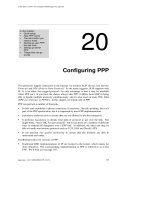Tài liệu Chapter 6: Chemical Equilibrium ppt
Bạn đang xem bản rút gọn của tài liệu. Xem và tải ngay bản đầy đủ của tài liệu tại đây (1.22 MB, 33 trang )
Chapter 6:
Chemical Equilibrium
I. The Chemical Composition of Aqueous Solutions
Electrolytes:
solutes which carry electrical charge - these
compounds are at least partially ionized
1. Strong Electrolytes = solutes almost
completely ionized
2. Weak Electrolytes = solutes only partially
ionized
Acids and Bases - electrolytes (can be weak or strong)
1. Bronsted-Lowery Theory:
¾ acids are proton donors
¾ bases are proton acceptors
2. Strong Acids and bases almost completely
ionized
3. Weak acids and bases (poorly ionized).
See Table 6-2 (memorize strong acids and bases)
a. Conjugate acids and bases:
when an acid donates a proton in an acid-base
reaction, it forms a conjugate base.
Likewise, when a base accepts a proton in an
acid-base reaction it forms a conjugate acid.
H
2
O (base) + HCOOH (acid) <===> H
3
O
+
(conj.
acid) + HCOO
-
(conj. base)
b. Amphiprotic solvents can be either acids or
bases:
H
2
O (acid) + CH
3
NH
2
(base) <===> OH
-
(conj.
base) + CH
3
NH
3
+
(conj. acid)
c. Autoprotolysis: when amphiprotic
solvents undergo self-ionization
2 H
2
O <=====> H
3
O
+
+ OH
-
K
w
This expression is called the ion-product of water and is
denoted
K
w
= [H
3
O
+
][OH
-
]
K
w
= 1.01 x 10
-14
at 25°C
pK
w
= -log K
w
= -log 1.01 x 10
-14
= 14
Acid and Base Strengths
Acid and base strengths may be determined by
using
¾ a differentiating solvent
.
That is, selecting a solvent which will accept
(or donate) a proton to one acid (or base) but
not another (example: use of glacial acetic acid
as solvent to compare HClO
4
and HCl acid
strength).
¾ a leveling solvent
is one in which all acids or
bases are dissociated to the same degree and
have equal acid (or base) strengths.
¾a differentiating solvent
CH
3
COOH + HClO
4
CH
3
COOH
2
+
+ClO
4
-
CH
3
COOH + HCl CH
3
COOH
2
+
+Cl
-
¾ a leveling solvent (H
2
O)
HClO
4
+ H
2
O H
3
O
+
+ClO
4
-
HCl + H
2
O H
3
O
+
+Cl
-
<====>
<====>
Table: Acids and Bases
Any Questions?
II. Chemical Equilibrium:
The ratio of the molar concentrations of reactants and
products is a constant at certain temperature.
H
2
O + HCOOH <===> H
3
O
+
+ HCOO
-
The square bracketed terms mean:
¾ Molar concentration if the species is a dissolved
solute
¾ Partial pressure in atm if species is a gas
¾ Unity if species is a pure liquid, pure solid, or
pure solvent (solvent in an extremely dilute
solution).
]HCOOH][OH[
]HCOO][OH[
K
2
-
3
a
+
=
III. Types of Equilibrium Constants (See Table 6-1)
A. The ion-product for water.
Water is poorly dissociated, but does undergo
autoprotolysis:
2 H
2
O <===> H
3
O
+
+ OH
-
and,
recalling that molar concentrations = 1 for
dilute solutions
K
w
= [H
3
O
+
] [OH
-
] = 1.01 X 10
-14
at 25
o
C
Also since -log K
w
= -log{[H
3
O
+
][OH
-
]}
= -log [H
3
O
+
]-log[OH
-
]
pK
w
= pH + pOH or 14 = pH + pOH
K
w
is dependent on temperature
B. Solubility Product Constants
For the solubility of Fe(OH)
3
, we can write
Fe(OH)
3
<===> Fe
3+
(aq) + 3 OH
-
(aq)
again, recalling that the molar concentration
of a pure solid = 1
we can write the solubility product:
[Fe
+3
] [OH
-
]
3
= K
sp
= 4 x 10
-38
The common ion effect
• Based upon Le Chatelier's Principle, if we
add an ion common to the solid to the
medium, the equilibrium will shift to make
the solid less
soluble.
THIS IS ALSO CALLED A MASS-ACTION EFFECT
Example 6-1: The common ion effect
1. The solubility, x, of Fe(OH)
3
in pure water
([OH
-
] = 10
–7
M) is:
Fe(OH)
3
<===> Fe
3+
(aq) + 3 OH
-
(aq)
[Fe
+3
][OH
-
]
3
= [Fe
+3
](10
-7
M)
3
= 4 X 10
-38
, and
[Fe
+3
] = 4 X 10
-17
M
2. when add 1.00 M NaOH
, [OH
-
] = 1.00 M, then
[Fe
+3
][1.00 M]
3
= [Fe
+3
](1.00)
3
= 4 X 10
-38
and
[Fe
+3
] = 4 X 10
-38
M
The common ion effect
• In the case of the ferric hydroxide, addition
of l.00 M KOH will make the Fe(OH)
3
(solid)
10
-21
times less soluble.
1 mole1 moleStoichiometric ratio 2 mole
]IO[
2
1
-
3
=
Example 6-2:
Stoichiometric ratio
2 mole
Ba(NO
3
)
2
Ba
2+
+ 2 NO
3
-
1 mole1 mole
Stoichiometric ratio
2 mole
[Ba
2+
]
total
= [Ba
2+
] from Ba(IO
3
)
2
+ [Ba
2+
] from Ba(NO
3
)
2
M0200.0M0200.0]IO[
2
1
-
3
≈+=
-92-
3
2-
3
2
sp
1.57x10 ]IO[0200.0]IO][Ba[K ===
+
48
-9
-
3
1080.21085.7
0200.0
1.57x10
]IO[
−−
=== xx
M
Example 6-3:
Any Questions?
C. Acid-Base Dissociation Constants
when a weak acid or base is dissolved in
water, it partially ionizes:
acid: HA + H
2
O <===> H
3
O
+
+ A
-
K
a
base: B + H
2
O <===> BH
+
+ OH
-
K
b
• HA + H
2
O <===> H
3
O
+
+ A
-
K
a
• A
-
+ H
2
O <===> HA + OH
-
K
b
K
a
K
b
= [H
3
O
+
][OH
-
] = K
w
so that as K
a
becomes smaller, the corresponding
K
b
for the acid's conjugate base becomes
greater (or the weaker the acid, the stronger of
conjugate base).
The same is true for weak bases.
1. Dissociation constants for conjugate acid/base pairs
O]][HA[
]][HA[OH
K
O]HA][H[
]O][H[A
K
2
-
-
b
2
3
-
a
==
+
2. Hydronium ion concentrations in solutions of
weak acids.
HA + H
2
O <===> H
3
O
+
+ A
-
K
a
2 H
2
O <===> H
3
O
+
+ OH
-
K
w
since K
a
usually >> K
w
, we normally can neglect
the water hydronium ion contribution (but not
always, particularly if the c
HA
is very low).
[A
-
] = [H
3
O
+
], and recalling that
c
HA
= [A
-
] + [HA] (analytical concentration)
c
HA
= [H
3
O
+
] + [HA] or
[HA] = c
HA
-[H
3
O
+
]
Equilibrium expression for the acid dissociation:
])O[H-C(
]O[H
Ka
3HA
2
3
+
+
=
[H
3
O
+
]
2
+ K
a
[H
3
O
+
] - K
a
c
HA
= 0
The positive solution to the quadratic equation is:
2
CK4KK
]O[H
HAa
2
aa
3
++−
=
+









